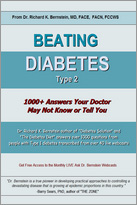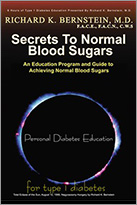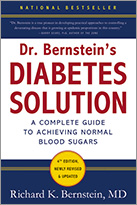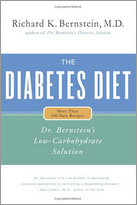The Insulin/Fat Connection
The primary source of body fat for most Americans is not dietary fat but carbohydrate, which is converted to blood sugar and then, with the aid of insulin, to fat by fat cells. Remember, insulin is our main fatbuilding hormone. Eat a plate of pasta. Your blood sugar will rise and your insulin level (if you have type 2 diabetes or are not diabetic) will also rise in order to cover, or prevent, the jump in blood sugar. All the blood sugar that is not burned as energy or stored as glycogen is turned into fat. So you could, in theory, acquire more body fat from eating a high-carbohydrate “fat-free” dessert than you would from eating a tender steak nicely marbled with fat. Even the fat in the steak is more likely to be stored if it is accompanied by bread, potatoes, corn, and so on.
The fatty-acid building blocks of fats can be metabolized (burned), stored, or converted by your body into other compounds, depending on what it requires. Consequently, fat is always in flux in the body, being stored, appearing in the blood, and being converted to energy. The amount of triglycerides (the storage form of fat) in your bloodstream at any given time will be determined by your heredity, your level of exercise, your blood sugar levels, your diet, your ratio of visceral (abdominal) fat to lean body mass (muscle), and especially by your recent consumption of carbohydrate.
The slim and fit tend to be very sensitive (i.e., responsive) to insulin and have low serum levels not only of triglycerides but insulin as well. But even their triglyceride levels will increase after a high-carbohydrate meal, as excess blood sugar is converted to fat. The higher the ratio of abdominal fat (and, to a lesser degree, total body fat) to lean body mass, the less sensitive to insulin you’ll tend to be. In the obese, triglycerides tend to be present at high levels in the bloodstream all the time. (This is sometimes exaggerated during weight loss because fat is appearing in the bloodstream as it comes out of storage to be converted into energy.)
Not only are high triglyceride levels a direct cause of insulin resistance, but they also contribute to fatty deposits on the walls of your blood vessels (atherosclerosis). Research demonstrates that if high concentrations of triglycerides are injected into the blood supply of the liver of a wellconditioned athlete, someone very sensitive to insulin, she will become temporarily insulin-resistant. (The most important thing to note here is that insulin resistance, as well as other risk factors for diabetic complications, can be reversed by eating less carbohydrate, normalizing blood sugars, and slimming down, which we’ll discuss in greater detail later on.)
If you become overweight, you’ll produce more insulin, become insulin-resistant (which will require you to produce yet more insulin), and become even more overweight because you’ll create more fat and store more fat. You’ll enter the vicious circle depicted in Figure 1-1. Consider that steak I mentioned earlier. As you know, the body can convert protein to blood sugar, but it does so at a very slow rate, and inefficiently. Serum insulin levels derived from the phase II insulin response or even from insulin injected before a meal may thus be sufficient to prevent a blood sugar rise from protein consumption by itself. Dietary fat cannot be converted to blood sugar, and therefore it doesn’t cause serum insulin levels or requirements for injected insulin to increase. Say you eat an 8-ounce steak with no carbohydrate side dish—this won’t require much insulin to keep your blood sugar steady, and the lower insulin level will cause only a small amount of the fat to be stored.
Now consider what would happen if you instead ate a “fat-free” dessert with exactly the same number of calories as that steak. Your insulin level will jump dramatically in order to cover the sugar and starches in the dessert. Remember, insulin is the fat-building and fat storage hormone. Since it’s dessert, you probably won’t be going out to run a marathon after eating, so the largest portion of your newly created blood sugar won’t get burned. Instead much of it will be turned into fat and stored.
Interestingly enough, eating fat with carbohydrate can actually slow the digestion of carbohydrate, so the jump in your blood sugar level might thereby be slowed. This would probably be relatively effective if you’re talking about eating a green salad with vinegar-and-oil dressing. But if you’re eating a regular dessert, or a baked potato with your steak, the slowdown in digestion would not prevent blood sugar elevation in a diabetic.
Despite what the popular media would have us believe, fat is not evil. In fact, many researchers are becoming quite concerned about the dangerous potential of “fat substitutes.” Fat is absolutely necessary for survival. Much of the brain is constructed from fatty acids. Without essential fatty acids—which, like essential amino acids, cannot be manufactured by the body and must be eaten—you would die. Fat substitutes such as the recently FDA-approved olestra (sold under the brand name of Olean and present in such products as Frito-Lay WOW! potato chips) bring about the specter of people trying to subsist on a no-fat diet, a diet that could kill them. (Olestra actually robs the body of important fat-soluble vitamins and essential fatty acids. The FDA has required that it contain additives of those vitamins. In test markets, some consumers have been made quite ill by the product, while others don’t see any effect. I don’t recommend it—it’s at best completely unnecessary.)
Diabetics are affected disproportionately by diseases such as atherosclerosis. This has led to the long-standing myth that diabetics have abnormal lipid profiles because they eat more fat than nondiabetics.* It was likewise once thought that dietary fat caused all the long-term complications of diabetes. For many years, this was taken as gospel by most in the medical community. In truth, however, the high lipid profiles in many diabetics with uncontrolled blood sugar have nothing to
do with the fat they consume. Most diabetics consume very little fat— they’ve been conditioned to fear it. High lipid profiles are a symptom not of excess dietary fat, but of high blood sugars. Indeed, even in most nondiabetics, the consumption of fat has little if anything to do with their lipid profiles.
* A lipid profile is the measurement of cholesterol, HDL (good cholesterol), LDL (bad cholesterol), and triglyceride levels in the blood. Some physicians now consider lipoprotein(a) to be an essential component of the lipid profile. (See Chapter 2.)
On the other hand, high consumption of carbohydrate, as we will discuss shortly, can cause “nondiabetics” to develop some of the complications usually associated with diabetes.
When I was on a very low fat, high-carbohydrate diet more than thirty years ago, I had high fasting triglycerides (usually over 250 mg/ dl) and high serum cholesterol (usually over 300 mg/dl), and I developed a number of vascular complications. When I went onto a very low carbohydrate diet and did not restrict my fat, my lipids plummeted. Now, at sixty-eight, I have the lipid profile of an Olympic athlete, apparently from eating a low-carbohydrate diet in order to normalize my blood sugars. That I exercise regularly probably doesn’t hurt my lipid profile, either—but I was also exercising when my lipid profile was abnormal.
Dare your physician. Ask him or her if his or her lipid profile on a low-fat diet can remotely compare to mine, on a high-fat, low carbohydrate diet:
• LDL—the “bad” cholesterol—63 (below 130 is considered normal)
• HDL—the “good” cholesterol—116 (above 30 is considered normal)
• Triglycerides—45 (below 150 is considered normal)
• Lipoprotein(a)—undetectable (below 30 is considered normal)
Contrary to popular myth, fat is not a demon. It’s the body’s way of storing energy and maintaining essential organs such as the brain. Without essential fatty acids, your body would cease to function.




